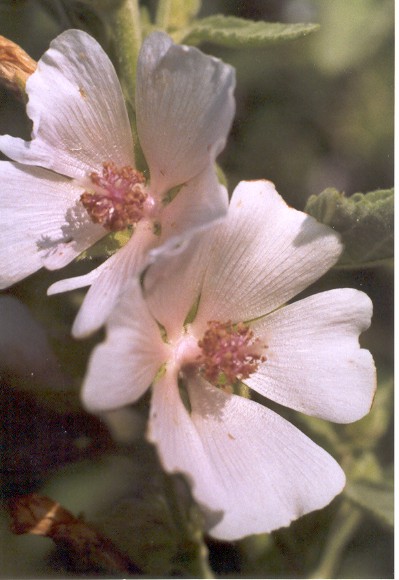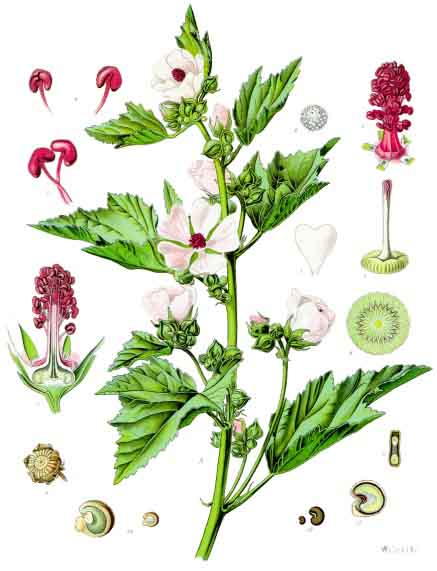
Althaea officinalis (L)
Synonyms and Common names: mallards, schloss tea, mortification root, sweet weed, hock herb, wymote, mauls, cheeses (after the flat, round fruit)
German = Malve, French = Guimauve, Spanish = Malvavisco, Italian = Malvavisce
Order: Malvaceae

Description: Althaea is an erect perennial herb, reaching a height of up to 150cm, with stalked, three- to five-lobed pale green velvety leaves densely clothed with stellate grey hairs. In the first year it grows a non-flowering stem. The pale pink to white flowers appear from June to September in the second year. Red united stamens grow on short stalks in the upper axils. The sepals are ovate, curving over the hairy fruit. The petals are 15-20mm long, sometimes shallowly notched, with purplish anthers. Althaea�s original habitat was in salty marshes or wet, brackish uncultivated ground in southern Europe, but it is now established throughout southern Britain and Europe, Australia and eastern North America. It is cultivated in Belgium, France and Germany.
Parts used: Root and leaf. The flowers may be used to make expectorant syrups.
Collection: The leaves are collected in summer during the flowering period. The root is unearthed in late autumn from plants which are at least two years old; it should be cleaned of root fibres and cork and dried immediately.
Constituents: Root: 15-20% mucilage (consisting largely of xylan and glucoseans), flavonoid glycosides, phenolic acids, tannins, up to 11% pectin, asparagin, up to 38% starch, polysaccharides, phytosterols, fatty acid esters and a lecithin. Leaves: up to 10% mucilage, flavonoids, traces of an essential oil
Actions: Root: Demulcent, diuretic, emollient, vulnerary. Leaf: Demulcent, expectorant, diuretic, emollient, antilithic. Flowers: expectorant
Indications: Leaf - bronchitis, respiratory catarrh, cystitis, urethritis, urinary gravel or calculi; locally for abscesses, boils and ulcers. Specifically indicated in respiratory catarrh associated with digestive weakness. Root - Gastritis, gastric or peptic ulceration, ulcerative colitis, enteritis, inflammation of the mouth or pharynx, respiratory catarrh with irritating dry cough, cystitis; locally for varicose veins and thrombotic ulcers. Specifically indicated in gastric or duodenal ulcer.
 Therapeutics and Pharmacology: Althaea root is used primarily for digestive problems and topically on the skin, whilst
the leaf is used particularly to treat the lungs and the urinary system,
although both root and leaf have similar properties.
Therapeutics and Pharmacology: Althaea root is used primarily for digestive problems and topically on the skin, whilst
the leaf is used particularly to treat the lungs and the urinary system,
although both root and leaf have similar properties.
The root is indicated in all inflammations of the digestive tract including mouth ulcers, hiatus hernia, gastritis, peptic ulcer, enteritis and colitis. Althaea contains large amounts of mucilage, making it an excellent demulcent which coats the gastrointestinal mucosa, particularly in the mouth and pharynx, thus protecting them from local irritation, and it counters excess stomach acid. It is also mildly laxative. Externally, the root is indicated in varicose veins and ulcers as well as in abscesses and boils, and it is used in cosmetics for weather-damaged skin. The peeled root may be given to teething babies to chew on. In vivo experiments have shown the anti-inflammatory effect of an ointment containing 20% aqueous root extract against skin irritation. In vitro experiments have shown a cold macerate of the root to inhibit mucociliary transport, while extracts of the root stimulate phagocytosis and the release of oxygen radicals and leukotrienes from human neutrophils. Potential anti-inflammatory and immunomodulatory effects have also been reported. Antimicrobial activity towards Pseudomonas aeruginosa, Proteus vulgaris and Staphylococcus aureus has been documented.
The leaf is an effective treatment for bronchitis, respiratory catarrh and irritating coughs. Its demulcent action helps to relieve dry coughs, bronchial asthma and pleurisy and soothes sore throats. Taken as a warm infusion, the leaves help to relieve cystitis and urinary frequency.
Caution: When using the tincture for digestive or urinary disorders, hot water should be used to reduce the alcohol content. Cold water extracts should be made if the mucilage content is to be preserved. However, since starch will not dissolve in cold water, if the root is to be used as a gargle for tonsillitis and inflamed gums, where the starch will be of benefit, it should be prepared with hot water.
Combinations: For pulmonary problems, Althaea herba may be combined with Marrubium, Glycyrrhiza and/or Tussilago. In ulcerative conditions, both internal or external, Althaea radix may be combined with Symphytum. It may also be used with Glycyrrhiza, Marrubium and/or Lobelia for coughs, and with Ulmus as a poultice or ointment for wounds, ulcers, boils and eczema.
Preparation and Dosage: (thrice daily)
Regulatory Status: GSL Schedule 1
Dried herb/root: 2-5g or by infusion/cold aqueous maceration
Liquid Extract: 1:1 in 25% alcohol, 2-5ml
Ointment: 5% powdered leaf/root in ointment base
Root Syrup (BPC 1949) 2-10ml
Additional Comments: The name Althaea is derived from the Greek altho, meaning to heal, and its medicinal qualities have been recognised since Ancient Egyptian times. Theophrastus reported that the root could be added to sweet wine to relieve coughs. Did you know - there is actually a board game called 'Theophrastus'. It is named after the medieval alchemist Theophrastus. The inspiration for the board game was derived from the fact that he would accept but one new apprentice a year. To be the one chosen among the many applicants was quite an accomplishment. Theophrastus put the applicants through rigorous challenges to test their alchemical talent and skill. In the games, you compete to be the alchemist's apprentice using your luck, determination and ingenuity!
Horace and Martial mentioned the laxative properties of the leaves and root; and Pliny wrote that 'whosoever shall take a spoonful of the Mallows shall that day be free from all diseases that may come to him'. Marshmallow is mentioned in the Bible and in Arabic and Chinese history as a valuable food during times of famine. In rural France, the young tops and leaves are eaten in salads for their kidney-stimulating effects. All members of the mallow family, such as the hollyhock and common mallow, have similar properties and can be used medicinally.
Bibliography
Bartram, T. 1995 Encyclopaedia of Herbal Medicine, 1st edn., Grace Publishers, Bournemouth.
BHMA 1983 British Herbal Pharmacopoeia, BHMA, Bournemouth.
Bradley, P.R. (ed.) 1992 British Herbal Compendium, Volume 1, BHMA, Bournemouth.
Bremness, L. 1994 Herbs, Dorling Kindersley Eyewitness Handbook, London.
BHMA 1983 British Herbal Pharmacopoeia, BHMA, Bournemouth.
Chevallier, A. 1996 The Encyclopaedia of Medicinal Plants, Dorling Kindersley, London.
ESCOP Monograph, 1996 Althaeae radix, European Scientific Committee on Phytotherapy
Grieve, M. 1931 A Modern Herbal, (ed. C.F. Leyel 1985), London.
Hoffmann, D. 1990 The New Holistic Herbal, Second Edition, Element, Shaftesbury.
Hyperhealth 1996 Natural Health and Nutrition Databank, v.96.1 CD-ROM, �In-Tele-Health, available from Healthworks, Leeds. ISBN 0-646-30942-0
Lust, J. 1990 The Herb Book, Bantam, London.
Mabey, R. (ed.) 1991 The Complete New Herbal, Penguin, London.
Mills, S.Y. 1993 The A-Z of Modern Herbalism, Diamond Books, London.
Newall, C.A., Anderson, L.A., & Phillipson, J.D. 1996 Herbal Medicines: A Guide for Health-care Professionals, The Pharmaceutical Press, London.
Ody, P. 1993 The Herb Society's Complete Medicinal Herbal, Dorling Kindersley, London.
Phillips, R. and Foy, N. 1990 Herbs, Pan Books, London.
Polunin, M. and Robbins, C. 1992 The Natural Pharmacy, Dorling Kindersley, London.
Press, B. & Gibbons, B. 1993 Wild Flowers of Britain and Europe: Photographic Field Guide, New Holland Publishers, London.
Prihoda, A. 1989 The Healing Powers of Nature, Octopus, London.
Rogers, S.K. 1995 British and Chinese Herbal Pharmacopoeia, Healthlink Software Systems, Australia
Weiss, R.F. 1991 Herbal Medicine, Beaconsfield Arcanum, Beaconsfield.
Wren, R.C. 1988 Potter's New Cyclopaedia of Botanical Drugs and Preparations, C.W.Daniel, Saffron Walden.










